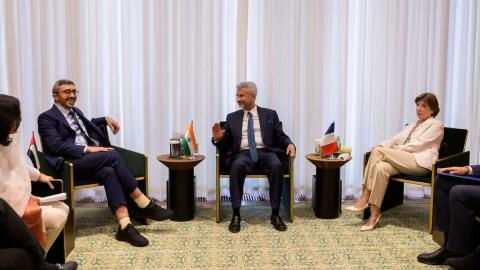On the sidelines of the United Nations General Assembly last September, the foreign ministers of India, France, and the United Arab Emirates drew up a trilateral strategy. Each already had strong bilateral ties, so they agreed to pursue a broader group partnership. India and France are part of a similar endeavor to forge a common agenda with Australia.
Earlier in the year, a virtual summit among India, Israel, the United Arab Emirates, and the United States—the I2U2 Group—heralded a “partnership for the future” and announced food security projects worth $2.3 billion. The initiatives involve investment in so-called food parks in India, which will link farms to consumer markets using Israeli and US agriculture technology.
Encouraged by the fragmentation of the world order, these groupings situated between bilateralism and multilateralism—called minilaterals or plurilaterals—are becoming more significant. US foreign-policy discourse currently focuses on peer competition with China and Russia, but most middle powers have shown they would prefer to shape a multi-aligned and multinetworked—even a “non-polar”—world. By working together on a specific agenda, smaller groups of countries avoid the complexities of decision-making in larger organizations.
With multilateral organizations such as the United Nations and the European Union unable to coordinate their foreign policies, some countries now prefer to operate outside formal institutions, opting for issue-based and short-term partnerships. Minilaterals are narrower in scope than multilaterals, usually informal, and bring together fewer states that share the same interest. They are practical, adaptable, economical, and voluntary—without being tied down by institutional constraints. Most multilateral institutions must cater to the competing expectations and ambitions of more countries, slowing down decision-making and incurring large bureaucratic costs.
In 2022, leaders from Singapore to India to the United Arab Emirates reiterated their desire to avoid choosing between China and the United States. Most minilaterals are likewise designed to enhance functional cooperation between like-minded countries, avoiding geopolitical conflict. For example, the I2U2 Group has been called the “new Quad.” But this is misleading: Unlike the original Quad—the Quadrilateral Security Dialogue involving Australia, India, Japan, and the United States—the new bloc focuses on technology infrastructure rather than competition with China or confronting Iran.
Even the original Quad is far from a military alliance or even a defense partnership, primarily due to its members’ hesitation in binding themselves through a formal military pact. At its last summit in Tokyo in May 2022, leaders identified global health security, climate, critical and emerging technologies, cyber, space, and infrastructure as areas of cooperation. They also announced the Indo-Pacific Partnership for Maritime Domain Awareness, which will enable tracking of dark shipping in the Pacific Islands, Southeast Asia, and the Indian Ocean region.
Most minilaterals are also voluntary and not legally binding. They involve multiple stakeholders, including corporations and nongovernmental organizations, instead of being state-centric; this makes them bottom-up rather than top-down. Issue-based minilaterals tend to be geographically noncongruous, unlike regional groupings such as the South Asian Association for Regional Cooperation, the Association of Southeast Asian Nations, the African Union, Organization of American States, and the European Union.
Minilateralism facilitates economic cooperation in ways that multilateralism does not. Most multilateral institutions get bogged down with competing interests. It is worth noting that some minilaterals, including the I2U2 group, developed organically with private-public partnerships—in this case, first among Israel, India, and the United Arab Emirates. The United States lent the group gravitas when it joined, but the trilateral formation was never in doubt after the Abraham Accords. Israel, India, and the United Arab Emirates are striving middle powers with a combined GDP of about $4 trillion, with abundant capital, technology, and markets.
Track II efforts—unofficial discussions among current and former officials organized by think tanks or other nongovernmental entities—are exploring the potential for a partnership that would add South Korea to the existing four-member I2U2 group. The momentum of such middle-power minilaterals could provide a base to keep adding other countries; the challenge would be to ensure that groups do not become too large, forcing them to deal with divergent interests and expectations.
India has become a leading proponent of minilateralism, an important element in its quest for multipolarity. Minilaterals allow India to maintain its policy of strategic autonomy—not allying itself with any major power—while enabling close partnerships with the United States and others in specific fields. For example, in 2019, India partnered with Japan and the United Arab Emirates to set up two trilateral projects in Africa, including a cancer hospital in Kenya and a tele-education center in Ethiopia. These projects paralleled Chinese development projects without explicitly projecting competition with China as the principal motivation. India’s minilateralism reflects an expanding breadth of partnerships. India and the United Arab Emirates, for example, now engage bilaterally, trilaterally, and quadrilaterally.
Minilateralism is also taking off with an evolving partnership in Latin America. With more than half the world’s lithium deposits, Argentina, Bolivia, and Chile, joined by Mexico, have formed a group to ensure that other countries don’t exploit their resources. The price of lithium carbonate rose almost 500 percent in the last two years and is expected to continue its rise as demand for batteries and electric vehicles expands, making this partnership necessary. Argentina is even considering launching a regional lithium association that could resemble the Organization of Petroleum Exporting Countries.
Minilaterals enable like-minded countries to work together in areas that are hindered by multilaterals or bigger groups of nations. For example, minilateral groups are pursuing common goals toward practical climate targets, while it has proved difficult to reach agreement on climate issues in larger multilateral settings. In a significant development, the United Arab Emirates and Indonesia announced a minilateral formation committed to bolstering mangrove conservation around the world during the UN climate summit in Egypt last November. Called the Mangrove Alliance for Climate, the group also includes India, Sri Lanka, Australia, Japan, and Spain.
Meanwhile, the United States is also expanding its involvement in minilateralism, making it a critical tool for economic diplomacy. The Chip 4 alliance brings together the United States, Taiwan, Japan, and South Korea to create a supply-chain grouping of leading chipmakers. Although the initiative is based on economic concerns, it also has an underlying geopolitical element: Its aim is to counter China’s dominance in designing and producing sophisticated semiconductors. US involvement in minilaterals may be motivated by geopolitical considerations, but the format also allows countries that don’t wish to focus on geopolitical competition to work with the United States on issues of mutual concern.
The changing geostrategic landscape has created new opportunities for cooperation among several middle powers. Minilateralism can provide a model for emerging markets and developing countries, too. Although its benefits seem to far outweigh its costs, it does come with some risks; minilateralism could make international organizations more ineffective than they already are and could promote contention. But in many cases, bilateral relations have reached a saturation point, and multilateral institutions are weak and ineffective. With or without the United States, minilateralism is likely to thrive in the years to come, much as nonalignment gained traction during the Cold War.
















